Subfamily Philanthinae
These wasps are mostly medium-sized and often colourfully marked with yellow or red bands and spots. Eyes widely separated, converging above. Forewing with three submarginal cells II and III, each receiving one recurrent vein. The head is large, broad and usually maculate.
Distribution
Afrotropical, Nearctic, Neotropical, Oriental and Palaearctic regions. Absent from Australia.
Diversity
3 genera in South Africa: Cerceris, Philanthus, Pseudoscolia.
Biology
Provision their nests with Hymenoptera, especially bees.
Links: WaspWeb; Sphecid Wasps of the World: A Generic Revision. Richard Mitchell Bohart, Arnold S. Menke
AW Insect Book: Sawflies, Wasps, Bees & Ants (Hymenoptera)
Moderator: Klipspringer
AW Insect Book: Sawflies, Wasps, Bees & Ants (Hymenoptera)
Bee-wolf Philanthus triangulum
Family: Crabronidae; Subfamily: Philanthinae
 © BluTuna
© BluTuna
 © BluTuna
© BluTuna
Kruger National Park
Genus Philanthus
Recurrent veins of forewing received one at SMC2 and the other at SMC3; inner margins of eyes deeply notched.
Description
Solitary wasp with bold yellow and black markings on the abdomen, males have trident-shaped markings between their bluish eyes while the larger females have a reddish stripe behind the eyes and a pale face.
Distribution
Widespread in Afrotropical & Palaearctic regions. From Europe to South Africa.
Biology
Nest in small to large aggregations in bare, sandy soil. Nests are provisioned with bees or wasps.
Links: WaspWeb
 © BluTuna
© BluTuna
Garden in Johannesburg
 © ExFmem
© ExFmem
Kgalagadi Transfrontier Park, Mata Mata camp
Family: Crabronidae; Subfamily: Philanthinae
 © BluTuna
© BluTuna © BluTuna
© BluTunaKruger National Park
Genus Philanthus
Recurrent veins of forewing received one at SMC2 and the other at SMC3; inner margins of eyes deeply notched.
Description
Solitary wasp with bold yellow and black markings on the abdomen, males have trident-shaped markings between their bluish eyes while the larger females have a reddish stripe behind the eyes and a pale face.
Distribution
Widespread in Afrotropical & Palaearctic regions. From Europe to South Africa.
Biology
Nest in small to large aggregations in bare, sandy soil. Nests are provisioned with bees or wasps.
Links: WaspWeb
 © BluTuna
© BluTunaGarden in Johannesburg
 © ExFmem
© ExFmemKgalagadi Transfrontier Park, Mata Mata camp
Hunting cannot be considered a sport as all contestants in a sport should know they are playing the game!
AW Insect Book: Sawflies, Wasps, Bees & Ants (Hymenoptera)
Bee-wolf Philanthus cf histrio
Superfamily Apoidea. Family Crabronidae. Subfamily Philanthinae
 © BluTuna
© BluTuna
Garden in Johannesburg
Links:
https://v3.boldsystems.org/index.php/Ta ... xid=653169
WaspWeb
Superfamily Apoidea. Family Crabronidae. Subfamily Philanthinae
 © BluTuna
© BluTunaGarden in Johannesburg
Links:
https://v3.boldsystems.org/index.php/Ta ... xid=653169
WaspWeb
AW Insect Book: Sawflies, Wasps, Bees & Ants (Hymenoptera)
Bee-wolf Philanthus sp.
Superfamily Apoidea. Family Crabronidae. Subfamily Philanthinae
 © BluTuna
© BluTuna
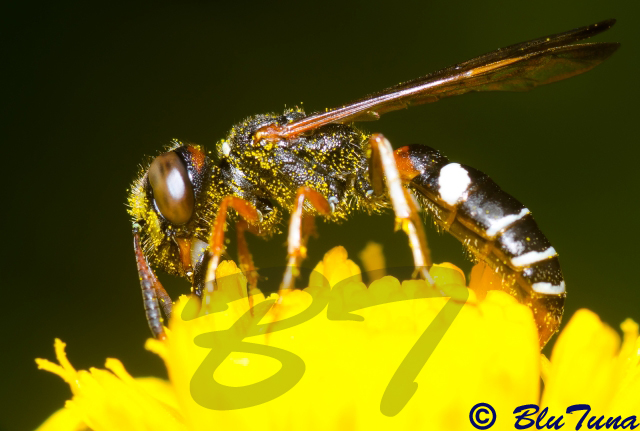 © BluTuna
© BluTuna
 © BluTuna
© BluTuna
Garden in Johannesburg
Links: WaspWeb
Superfamily Apoidea. Family Crabronidae. Subfamily Philanthinae
 © BluTuna
© BluTuna © BluTuna
© BluTuna  © BluTuna
© BluTunaGarden in Johannesburg
Links: WaspWeb
AW Insect Book: Sawflies, Wasps, Bees & Ants (Hymenoptera)
Family Sphecidae (Sand Wasps, Cricket Hunters, Mud Daubers & Digger Wasps)
The Sphecidae sensu strictu are a large family of wasps, referred to as Sand wasps, Cricket hunters, Mud daubers & Digger wasps. Sphecidae are often difficult to recognize because of very diverse size, shape and colour, some are thread-waisted and others are vespid-like, but all have pronotum that is short and collar-like, with posteriorly directed rounded lobe.
The Sphecidae wasps can be recognized by some diagnostic characters such as: gaster with cylindrical elongate petiole composed of sternum only unless it has two section as in Ammophila , inner orbits of eyes without notch, mandibles without a notch on externo-ventral margin, notauli on scutum absent but weak and short when present, jugal lobe of hind wing large containing an anal vein, no pygidial plate, male with 13 and female with 12 antennal segments.
They are variable in size (body length 1-40 mm), with relatively broad head and a pronotum that forms a more-or-less raised collar, its rear margin not reaching the base of the forewings.
Distribution
Worldwide.
Diversity
720 species in 19 genera worldwide.
The Sphecidae are currently represented by four subfamilies in South Africa:
Ammophilinae
Chloriontinae
Sceliphrinae
Sphecinae
Biology
Predators of a variety of arthropods including spiders (Aranaea), cockroaches (Dictyoptera), grasshoppers (Orthoptera), and caterpillars of moths and butterflies (Lepidoptera) or larvae of other wasps (Hymenoptera). Most species mass provision their nest with prey items on which they lay a single egg, however, some sphecines rear multiple larvae in a single cell. Nests are either constructed from mud or rarely resin, or are created by burrowing in the soil. Pre-existing cavities are also used as nesting sites.
Links: WaspWeb
The Sphecidae sensu strictu are a large family of wasps, referred to as Sand wasps, Cricket hunters, Mud daubers & Digger wasps. Sphecidae are often difficult to recognize because of very diverse size, shape and colour, some are thread-waisted and others are vespid-like, but all have pronotum that is short and collar-like, with posteriorly directed rounded lobe.
The Sphecidae wasps can be recognized by some diagnostic characters such as: gaster with cylindrical elongate petiole composed of sternum only unless it has two section as in Ammophila , inner orbits of eyes without notch, mandibles without a notch on externo-ventral margin, notauli on scutum absent but weak and short when present, jugal lobe of hind wing large containing an anal vein, no pygidial plate, male with 13 and female with 12 antennal segments.
They are variable in size (body length 1-40 mm), with relatively broad head and a pronotum that forms a more-or-less raised collar, its rear margin not reaching the base of the forewings.
Distribution
Worldwide.
Diversity
720 species in 19 genera worldwide.
The Sphecidae are currently represented by four subfamilies in South Africa:
Ammophilinae
Chloriontinae
Sceliphrinae
Sphecinae
Biology
Predators of a variety of arthropods including spiders (Aranaea), cockroaches (Dictyoptera), grasshoppers (Orthoptera), and caterpillars of moths and butterflies (Lepidoptera) or larvae of other wasps (Hymenoptera). Most species mass provision their nest with prey items on which they lay a single egg, however, some sphecines rear multiple larvae in a single cell. Nests are either constructed from mud or rarely resin, or are created by burrowing in the soil. Pre-existing cavities are also used as nesting sites.
Links: WaspWeb
AW Insect Book: Sawflies, Wasps, Bees & Ants (Hymenoptera)
Thread-waisted Wasp Ammophila ferrugineipes
Superfamily Apoidea. Family Sphecidae. Subfamily Ammophilinae
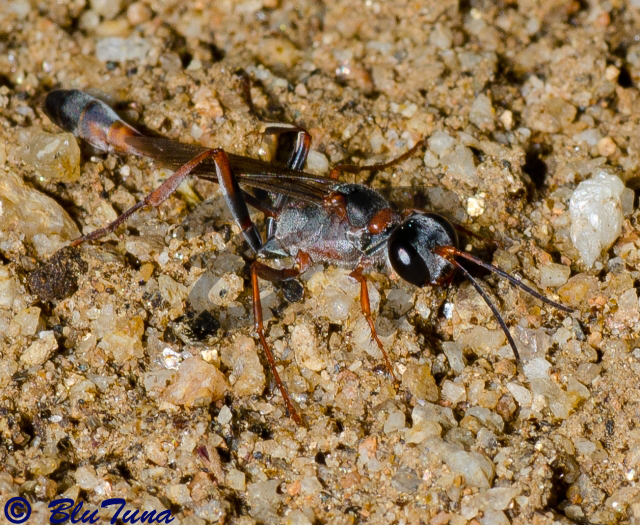 © BluTuna
© BluTuna
Female, Kruger National Park
Distribution
Ethiopia, Kenya, Mozambique, Senegal, South Africa, Sudan, Democratic Republic of Congo.
Biology
Females excavate an unbranched tunnel in sandy soil, and provision the nest with caterpillars (Lepidoptera) for their larva to feed on. This provsioning can be progressive with new caterpillars being provided as the larva require, or as a once off mass provision, each nest being provided with a single large or many small prey items.
"A. ferrugineipes practised a form of progressive provisioning and maintained several nests at a time, the only Afrotropical species, and the fifth species worldwide, known so far to do so."
From - "Nesting strategies in some southern African species of Ammophila (Hymenoptera: Sphecidae)" (Journal of Natural History Volume 23, Issue 1, 1989)
Links: WaspWeb
Superfamily Apoidea. Family Sphecidae. Subfamily Ammophilinae
 © BluTuna
© BluTunaFemale, Kruger National Park
Distribution
Ethiopia, Kenya, Mozambique, Senegal, South Africa, Sudan, Democratic Republic of Congo.
Biology
Females excavate an unbranched tunnel in sandy soil, and provision the nest with caterpillars (Lepidoptera) for their larva to feed on. This provsioning can be progressive with new caterpillars being provided as the larva require, or as a once off mass provision, each nest being provided with a single large or many small prey items.
"A. ferrugineipes practised a form of progressive provisioning and maintained several nests at a time, the only Afrotropical species, and the fifth species worldwide, known so far to do so."
From - "Nesting strategies in some southern African species of Ammophila (Hymenoptera: Sphecidae)" (Journal of Natural History Volume 23, Issue 1, 1989)
Links: WaspWeb
Hunting cannot be considered a sport as all contestants in a sport should know they are playing the game!
AW Insect Book: Sawflies, Wasps, Bees & Ants (Hymenoptera)
Thread-waisted Wasp Ammophila sp.
Superfamily Apoidea. Family Sphecidae. Subfamily Ammophilinae
 © ExFmem
© ExFmem
Female shown using the comb-like sand rakes on the fore tarsi for excavating her tunnel.
 © ExFmem
© ExFmem
Nossob Camp Walking Trail Nov. 2012
 © ExFmem
© ExFmem
Kgalagadi Transfrontier Park
There are 18 similar species of Ammophila in South Africa.
Generic Description
Ammophila range in length from 8 to 37 mm. A few species are entirely black, but most Ammophila have a partly or all red gaster. The legs are commonly partly red. In a few species the head and/or thorax are red. Males usually are less extensively red than females; sometimes the males are quite differently coloured. The wings are usually clear, sometimes yellowish or infumate. Species of arid regions have often head and thorax covered with appressed silver hair.
Apex of sternum I not reaching the base of sternum II; intervening space usually long and consisting of membrane and a ligament; spiracle of termum I located at or beyond level of sternum I apex; sternum I usually bent downward or straight at level of tergum I base.
Biology
Females excavate an unbranched tunnel in sandy soil, and provision the nest with caterpillars (Lepidoptera) for their larva to feed on. This provisioning can be progressive with new caterpillars being provided as the larva require, or as a once off mass provision, each nest being provided with a single large or many small prey items.
Links: WaspWeb
Superfamily Apoidea. Family Sphecidae. Subfamily Ammophilinae
 © ExFmem
© ExFmemFemale shown using the comb-like sand rakes on the fore tarsi for excavating her tunnel.
 © ExFmem
© ExFmemNossob Camp Walking Trail Nov. 2012
 © ExFmem
© ExFmemKgalagadi Transfrontier Park
There are 18 similar species of Ammophila in South Africa.
Generic Description
Ammophila range in length from 8 to 37 mm. A few species are entirely black, but most Ammophila have a partly or all red gaster. The legs are commonly partly red. In a few species the head and/or thorax are red. Males usually are less extensively red than females; sometimes the males are quite differently coloured. The wings are usually clear, sometimes yellowish or infumate. Species of arid regions have often head and thorax covered with appressed silver hair.
Apex of sternum I not reaching the base of sternum II; intervening space usually long and consisting of membrane and a ligament; spiracle of termum I located at or beyond level of sternum I apex; sternum I usually bent downward or straight at level of tergum I base.
Biology
Females excavate an unbranched tunnel in sandy soil, and provision the nest with caterpillars (Lepidoptera) for their larva to feed on. This provisioning can be progressive with new caterpillars being provided as the larva require, or as a once off mass provision, each nest being provided with a single large or many small prey items.
Links: WaspWeb
AW Insect Book: Sawflies, Wasps, Bees & Ants (Hymenoptera)
Thread-waisted Wasp Ammophila sp.
Superfamily Apoidea. Family Sphecidae. Subfamily Ammophilinae
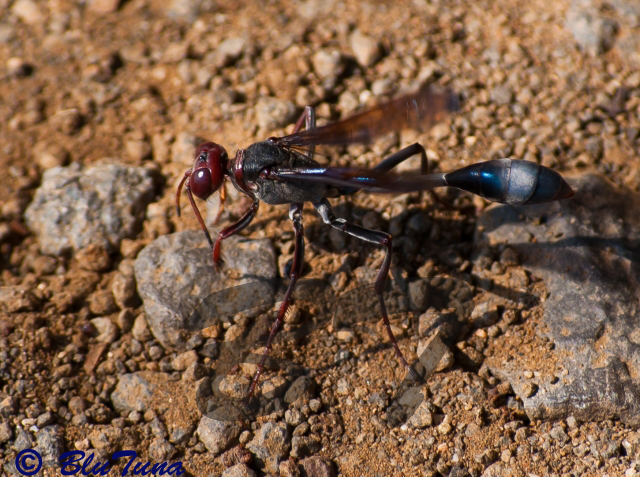 © BluTuna
© BluTuna
 © BluTuna
© BluTuna
Timbavati Picnic spot, Kruger National Park
Links: WaspWeb
Superfamily Apoidea. Family Sphecidae. Subfamily Ammophilinae
 © BluTuna
© BluTuna © BluTuna
© BluTunaTimbavati Picnic spot, Kruger National Park
Links: WaspWeb
Hunting cannot be considered a sport as all contestants in a sport should know they are playing the game!
AW Insect Book: Sawflies, Wasps, Bees & Ants (Hymenoptera)
False Mud Dauber Wasp Chalybion spinolae
Superfamily Apoidea. Family Sphecidae. Subfamily Sceliphrinae
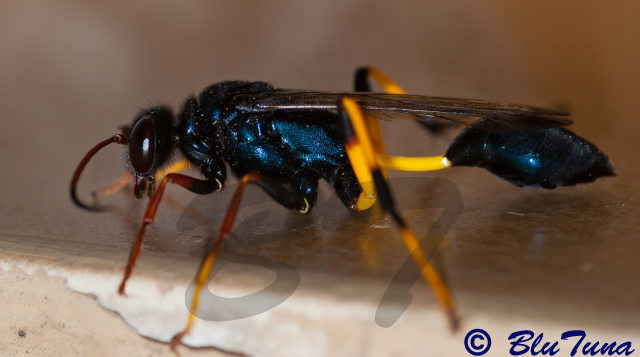 © BluTuna
© BluTuna
Maroela, Kruger National Park
Diagnosis
Superficially similar to Sceliphron spirifex and related species, such as S. quartinae, but distinguishable by the metallic blue lustre of the body (Sceliphron spirifex has a matt black body) and colour of the femur and tibia of the front and mid legs, which are reddish brown (yellow and black in Sceliphron spirifex). Females are also readily identifiable by the reddish-orange antennae, but males have black antennae like Sceliphron spirifex. The petiole is relatively shorter. The form of the propodeum is distinctive: there is a central longitudinal ridge with a distinct posterior pit.
Distribution
Ethiopia, South Africa, Tanzania, Democratic Republic of Congo.
Biology
Females prey on Button spiders (Latrodectus), but also take other members of the family Theriidiidae such as False Button spiders (Steatoda) (see above record). They mass provision single cells in crevices or burrows excavated in exposed vertical soil banks. A single egg is laid on the largest spider. Prior to provisioning with spiders, the nest is lined and the cell constructed with mud collected from a nearby water source. Females use vibrations, produced by their flight mechanism, that are transmitted through the mandibles to assist with application of mud to the inside of the nest. Water may be collected by the female and carried in her crop to be used to initially soften the bank for excavation of the burrow. The nest entrance is sealed with a mud plug laid down by spiral addition of mud pellets. The finished plug is slightly concave. Further nests may then be constructed in close proximity to the first
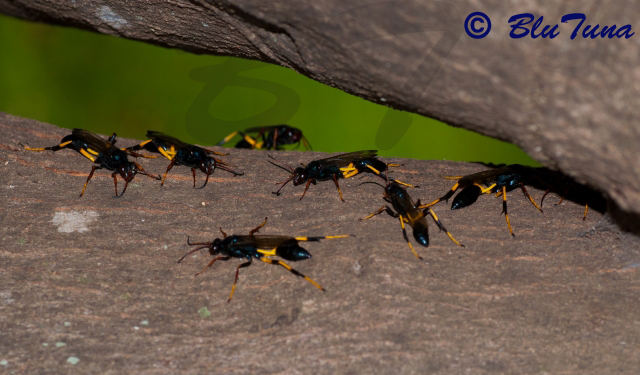 © BluTuna
© BluTuna
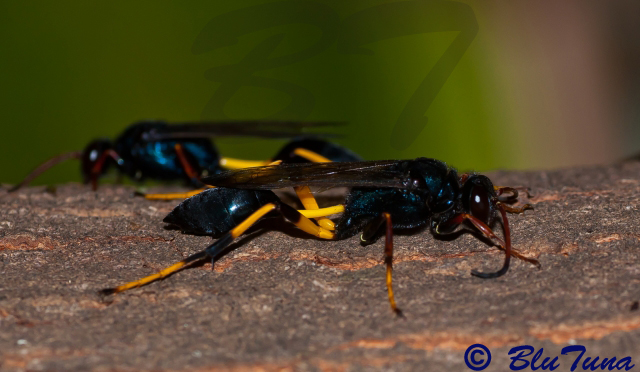 © BluTuna
© BluTuna
Balule, Kruger National Park
https://www.waspweb.org/Apoidea/Sphecid ... inolae.htm
Superfamily Apoidea. Family Sphecidae. Subfamily Sceliphrinae
 © BluTuna
© BluTunaMaroela, Kruger National Park
Diagnosis
Superficially similar to Sceliphron spirifex and related species, such as S. quartinae, but distinguishable by the metallic blue lustre of the body (Sceliphron spirifex has a matt black body) and colour of the femur and tibia of the front and mid legs, which are reddish brown (yellow and black in Sceliphron spirifex). Females are also readily identifiable by the reddish-orange antennae, but males have black antennae like Sceliphron spirifex. The petiole is relatively shorter. The form of the propodeum is distinctive: there is a central longitudinal ridge with a distinct posterior pit.
Distribution
Ethiopia, South Africa, Tanzania, Democratic Republic of Congo.
Biology
Females prey on Button spiders (Latrodectus), but also take other members of the family Theriidiidae such as False Button spiders (Steatoda) (see above record). They mass provision single cells in crevices or burrows excavated in exposed vertical soil banks. A single egg is laid on the largest spider. Prior to provisioning with spiders, the nest is lined and the cell constructed with mud collected from a nearby water source. Females use vibrations, produced by their flight mechanism, that are transmitted through the mandibles to assist with application of mud to the inside of the nest. Water may be collected by the female and carried in her crop to be used to initially soften the bank for excavation of the burrow. The nest entrance is sealed with a mud plug laid down by spiral addition of mud pellets. The finished plug is slightly concave. Further nests may then be constructed in close proximity to the first
 © BluTuna
© BluTuna © BluTuna
© BluTunaBalule, Kruger National Park
https://www.waspweb.org/Apoidea/Sphecid ... inolae.htm
AW Insect Book: Sawflies, Wasps, Bees & Ants (Hymenoptera)
Digger Wasp Sphex sp.
Superfamily Apoidea. Family Sphecidae. Subfamily Sphecinae. Tribe Sphecini
 © BluTuna
© BluTuna
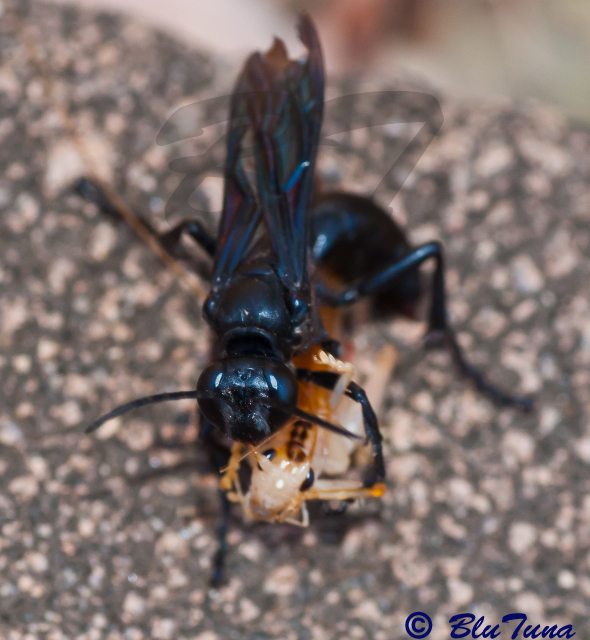 © BluTuna
© BluTuna
N'wanetsi Lookout, Kruger National Park
Sphex is a cosmopolitan genus that currently encompasses 118 species worldwide. Most species are handsome, large and often colorful and attract the attention of collectors. The species are geographically distributed as follows (some species occur in more than one geographic area): Palearctic: 19, Nearctic: 13, Neotropic: 31, Afrotropic: 30, In-domalaya: 22 and Australasia + Oceania: 34.
Most species of Sphex are gregarious and nest in large groups of several individuals. Ground nests contain 3-10 separate cells which are built in side branches of the main tunnel, usually approximately 10-15 cm deep, but sometimes deeper depending on species and soil type. Females travel up to 2.5 km from the nest when searching for prey. The number of prey items per cell varies from 3 or 4 to 6 or 7. They prey on grasshoppers (Orthoptera) in the family Tettigoniidae, and less often crickets in the families Gryllacrididae and Gyrllidae.
Several characters that are diagnostic for species of Sphex are strongly sexually dimorphic.
Links: WaspWeb
Superfamily Apoidea. Family Sphecidae. Subfamily Sphecinae. Tribe Sphecini
 © BluTuna
© BluTuna © BluTuna
© BluTunaN'wanetsi Lookout, Kruger National Park
Sphex is a cosmopolitan genus that currently encompasses 118 species worldwide. Most species are handsome, large and often colorful and attract the attention of collectors. The species are geographically distributed as follows (some species occur in more than one geographic area): Palearctic: 19, Nearctic: 13, Neotropic: 31, Afrotropic: 30, In-domalaya: 22 and Australasia + Oceania: 34.
Most species of Sphex are gregarious and nest in large groups of several individuals. Ground nests contain 3-10 separate cells which are built in side branches of the main tunnel, usually approximately 10-15 cm deep, but sometimes deeper depending on species and soil type. Females travel up to 2.5 km from the nest when searching for prey. The number of prey items per cell varies from 3 or 4 to 6 or 7. They prey on grasshoppers (Orthoptera) in the family Tettigoniidae, and less often crickets in the families Gryllacrididae and Gyrllidae.
Several characters that are diagnostic for species of Sphex are strongly sexually dimorphic.
Links: WaspWeb


